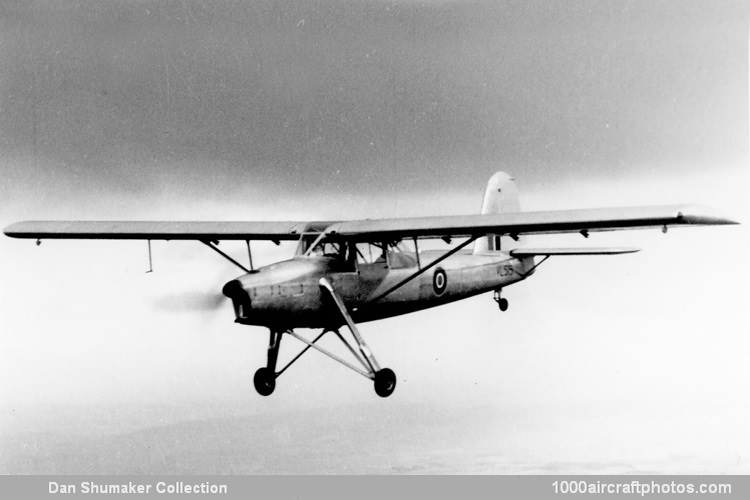02/28/2014. Remarks by Johan Visschedijk: "First aircraft produced by Scottish Aviation Ltd., the Prestwick Pioneer was designed by Robert McIntyre to meet the Air Ministry Specification A.4/45 for a communications aircraft capable of operating into, and out of, confined spaces. It was a strut-braced, high-wing cabin monoplane of all-metal, stressed-skin construction powered by a 240 hp Gipsy Queen 32.
Full-span, controllable leading edge slats and Fowler type trailing edge flaps of generous area imparted sensational take off, landing and slow flying characteristics. Adequate trimming and control at forward speeds of the order of 30 mph (48 kmh) were achieved by the use of an electrically operated, variable incidence tail plane and an unusually large rudder and elevator. The pilot sat centrally with maximum view, three passengers and luggage being accommodated behind.
Serialed VL515 the first prototype made its static debut at the SBAC Show in September 1947, making its first flight on November 5, but when no military contract was awarded, development continued for civil purposes. Trials proceeded throughout 1948 in the hands of test pilots N.J. Capper and R.C.W. Ellison, the aircraft, re-engined with a Gipsy Queen 34, flying under 'Class B' conditions as G-31-1. It was exhibited as such at the 1948 SBAC Show, even though already registered G-AKBF. A decision to increase the passenger seats to four and improve the performance called for the installation of a more powerful engine.
A number of power plants were considered, including the Pratt and Whitney Wasp R-1340, several of which were available following the dismantling of the company's Fokker F.22 G-AFZP. Final choice fell on the Alvis Leonides nine-cylinder radial, the reworked prototype making its first flight as the Prestwick Pioneer 2 in June 1950. Steep take off and short landing demonstrations by N.J. Capper at the 1950, 1951 and 1952 SBAC Shows drew attention, not only to its improved military potential and civil applications in the light transport, ambulance or agricultural roles but also to its docility. With the port half of the elevator torn away in a steep take off at the 1952 Show, the Prestwick Pioneer continued its circuit to make an uneventful landing.
The issue of an unrestricted CofA in May 1952, followed by helicopter style landings on 300 ft (91 m) strips on the Hebridean islands of Mull and Iona, rounded off the development of Scotland's first commercial design and Britain's first STOL transport. The adoption of the Prestwick Pioneer for casualty evacuation in the Malayan jungles by the RAF necessitated a production line at Prestwick, and by the end of 1958 in all 59 aircraft had been completed, including the prototype, the forty Pioneer CC.Mk.1 for the RAF and several for the Ceylon and Malayan Air Forces.
During this period six aircraft were employed by the manufacturers as temporary civil demonstrators. The third RAF aircraft became G-ANAZ for a few days in September 1953, purely for ferrying to, and exhibition at, the Farnborough SBAC Show. The fifth aircraft appeared in the following year as G-ANRG and afterwards masqueraded as an RAF aircraft XH469 for participation in Exercise Battle Royal and the Battle of Britain display at Hendon. In the following June G-ANRG was despatched to the Far East, but during demonstration flights at Rangoon by A.F. Coker on July 23, 1955, was seriously damaged and shipped home for repair.
A new demonstrator G-AODZ then completed the Far East sales tour. It was leased to Film Aviation Services Ltd. early in 1958 and went on location in French Equatorial Africa, piloted by K. Sissons, during the filming of 'Roots of Heaven', but returned to Prestwick for overhaul before leaving on a sales tour of Israel on August 24, 1958. European sales tours had been undertaken with G-AOGF and G-AOGK in 1956. In the same year G-AOUE went to the USA for evaluation by the American Authorities but nosed over when taking off on loose sand from Fort Bragg, North Carolina on November 6, returning as USAF air freight to Prestwick, where it was deemed irreparable and scrapped.
To avoid confusion with the Twin Pioneer, production of which was increasing, the civil Prestwick Pioneer 2 was redesignated Pioneer 1 in March 1957. Demonstrators G-AOFG and G-AOGK were eventually sold and left Prestwick together on March 2, 1958, at the commencement of their delivery flight to the Iranian Customs Authority and were engaged on anti-smuggling patrols. Two others, test flown during the following summer under civil marks as G-APNW and G-APNX, were crated and dispatched to the Royal Ceylon Air Force."
